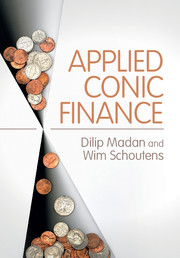Book contents
- Frontmatter
- Dedication
- Contents
- Preface
- Acknowledgements
- 1 Financial Mathematics Principles
- 2 Stochastic Processes and Financial Models
- 3 Numerical Techniques
- 4 Conic Finance
- 5 Conic Pricing
- 6 Applications of Conic Finance
- 7 Conic Portfolio Theory
- 8 Conic Hedging
- 9 Hedging Insurance Contracts
- 10 Option Positioning
- 11 Conic Trading
- References
- Index
9 - Hedging Insurance Contracts
Published online by Cambridge University Press: 27 October 2016
- Frontmatter
- Dedication
- Contents
- Preface
- Acknowledgements
- 1 Financial Mathematics Principles
- 2 Stochastic Processes and Financial Models
- 3 Numerical Techniques
- 4 Conic Finance
- 5 Conic Pricing
- 6 Applications of Conic Finance
- 7 Conic Portfolio Theory
- 8 Conic Hedging
- 9 Hedging Insurance Contracts
- 10 Option Positioning
- 11 Conic Trading
- References
- Index
Summary
In this chapter we illustrate the conic finance theory in the setting of equitylinked insurance contracts. We elaborate on how to improve the risk profile and risk-manage such types of contracts (see also Carr et al. (2016)).
Insurance books often combine exposures to financial and non-financial risks, with the financial component often being quite complex and involving pathdependent aspects. Yet one anticipates that movements in security prices over the near term can have considerable effects on the present value of payouts associated with the insurance liabilities. Taking positions in the options markets of related securities may constitute a good hedge for the insurance book. The purpose here is to present a detailed methodology for constructing such option hedges. The purpose of the hedge is not that of replication or risk elimination, as this is not expected to be possible, but one of improving the overall quality of the position.
Implementation of the methodology requires an ability to simulate the paths, at a regular frequency, of relevant underliers and the associated present value of the related insurance cash flows. We introduce as hedging assets positions in the underlying stocks and out of the money options on these stocks. The residual position that we investigate is given by earnings on the hedge positions together with the present value of the insurance contract's cash flows. The hedge positions are sought in a way that makes the package more diversified. Diversity is measured by the gap between the ask price of the package and the sum of the ask prices of the components of the package.We hence face an optimization problem in the number of all options on all underliers plus the number of underliers for the stock positions. The hedge is designed to numerically solve this optimization problem.
We exemplify the methodology on Guaranteed Minimum Withdrawal Benefit Variable Annuities (GMWBVA). When such deals are struck, or more generally whenever these deals are on the books, they are exposed to market risk. Using a particular model, one can try to estimate this risk and, for example, estimate what the marked-to-market profit or loss would be if the underlying stock or index were to move.
- Type
- Chapter
- Information
- Applied Conic Finance , pp. 148 - 157Publisher: Cambridge University PressPrint publication year: 2016



